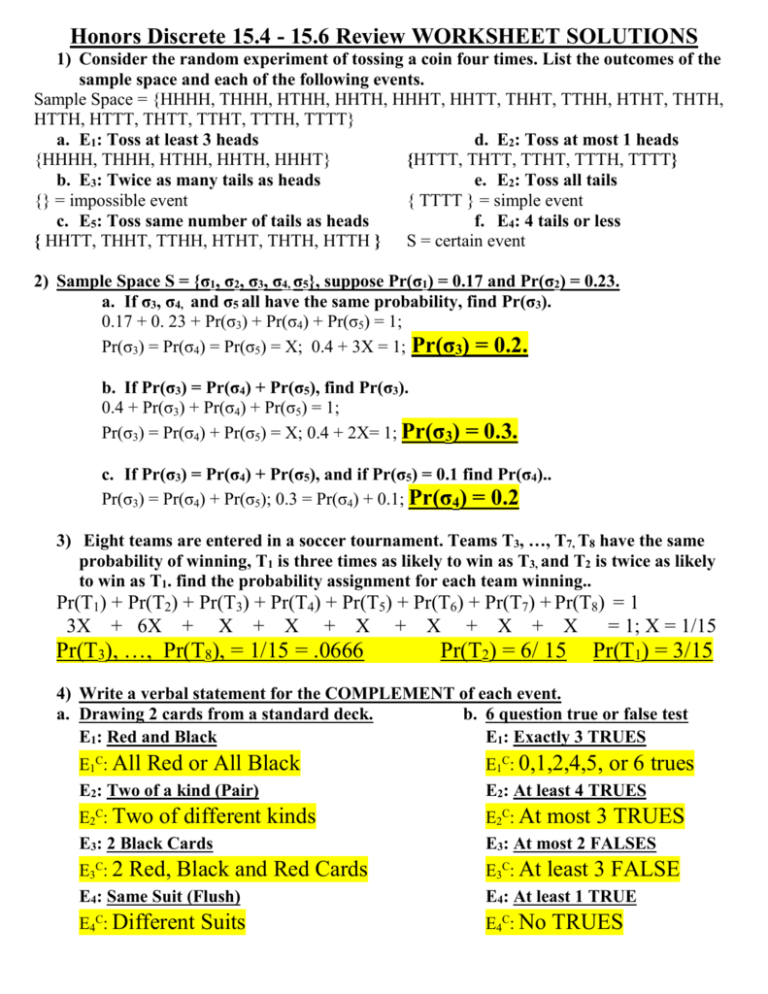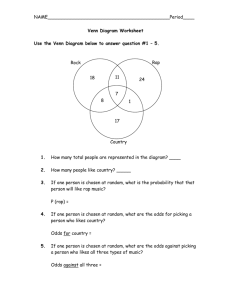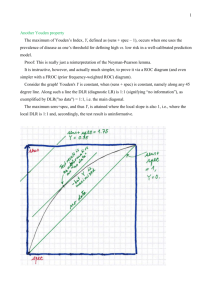Honors Discrete Chapter 15: Multiplication Rule Worksheet
advertisement

Honors Discrete 15.4 - 15.6 Review WORKSHEET SOLUTIONS
1) Consider the random experiment of tossing a coin four times. List the outcomes of the
sample space and each of the following events.
Sample Space = {HHHH, THHH, HTHH, HHTH, HHHT, HHTT, THHT, TTHH, HTHT, THTH,
HTTH, HTTT, THTT, TTHT, TTTH, TTTT}
a. E1: Toss at least 3 heads
d. E2: Toss at most 1 heads
{HHHH, THHH, HTHH, HHTH, HHHT}
{HTTT, THTT, TTHT, TTTH, TTTT}
b. E3: Twice as many tails as heads
e. E2: Toss all tails
{} = impossible event
{ TTTT } = simple event
c. E5: Toss same number of tails as heads
f. E4: 4 tails or less
{ HHTT, THHT, TTHH, HTHT, THTH, HTTH } S = certain event
2) Sample Space S = {σ1, σ2, σ3, σ4, σ5}, suppose Pr(σ1) = 0.17 and Pr(σ2) = 0.23.
a. If σ3, σ4, and σ5 all have the same probability, find Pr(σ3).
0.17 + 0. 23 + Pr(σ3) + Pr(σ4) + Pr(σ5) = 1;
Pr(σ3) = Pr(σ4) = Pr(σ5) = X; 0.4 + 3X = 1; Pr(σ3) = 0.2.
b. If Pr(σ3) = Pr(σ4) + Pr(σ5), find Pr(σ3).
0.4 + Pr(σ3) + Pr(σ4) + Pr(σ5) = 1;
Pr(σ3) = Pr(σ4) + Pr(σ5) = X; 0.4 + 2X= 1; Pr(σ3)
= 0.3.
c. If Pr(σ3) = Pr(σ4) + Pr(σ5), and if Pr(σ5) = 0.1 find Pr(σ4)..
Pr(σ3) = Pr(σ4) + Pr(σ5); 0.3 = Pr(σ4) + 0.1; Pr(σ4) = 0.2
3) Eight teams are entered in a soccer tournament. Teams T3, …, T7, T8 have the same
probability of winning, T1 is three times as likely to win as T3, and T2 is twice as likely
to win as T1. find the probability assignment for each team winning..
Pr(T1) + Pr(T2) + Pr(T3) + Pr(T4) + Pr(T5) + Pr(T6) + Pr(T7) + Pr(T8) = 1
3X + 6X + X + X + X + X + X + X
= 1; X = 1/15
Pr(T3), …, Pr(T8), = 1/15 = .0666
Pr(T2) = 6/ 15
Pr(T1) = 3/15
4) Write a verbal statement for the COMPLEMENT of each event.
a. Drawing 2 cards from a standard deck.
b. 6 question true or false test
E1: Red and Black
E1: Exactly 3 TRUES
E1C: All Red or All Black
E2: Two of a kind (Pair)
E1C: 0,1,2,4,5, or 6 trues
E2: At least 4 TRUES
E2C: Two of different
E3: 2 Black Cards
E2C: At most 3 TRUES
E3: At most 2 FALSES
kinds
E3C: 2 Red, Black and
E4: Same Suit (Flush)
E4C: Different
Suits
Red Cards
E3C: At least 3 FALSE
E4: At least 1 TRUE
E4C: No
TRUES
5) A couple is planning to have 5 children and is concerned about their gender.
a. How many different 5 children outcomes for boys and girls?
2 5 32
b. What is the probability the couple will have exactly 2 boys?
5
C2
25
10
32
c. What is the probability the couple will have at least 1 boy?
5
C 1 5 C 2 5 C 3 5 C 4 5 C 5 31
5
32
2
d. What is the probability the couple will have at most 2 girls?
5
C 0 5 C1 5 C 2
25
16
32
6) Draw 2 card from a standard deck of 52 without replacement
a. What is the probability to draw 2 of a kind?
52 3 13 (4 3) 156
or
52 51
52 51
2652
b. What is the probability to draw 2 different cards by value?
52 48 2496
52 51 2652
c. What is the probability of 2 black cards?
26 25 650
52 51 2652
d. What is the probability of a red then black?
26 26 676
RB =
52 51 2652
7) Draw 2 card from a standard deck of 52 with replacement.
a. What is the probability to draw 2 different cards by value?
52 48 2496
2704
52 2
b. What is the probability of 2 non-face cards?
40 40 1600
2704
52 2
c. What is the probability of a red and black?
26 2 26 2 1352
RB + BR=
52 2 52 2 2704
d. What is the probability of a face card then non-face card?
12 40 480
2704
52 2
8) 8 red marbles, 7 green marbles, and 5 blue marbles are in a bag and each time a
marble is chosen it is replaced back in the bag for the next draw.
8 5
40
1
a. Find Pr(Red then Blue)
20 20 400 10
8 7
56
7
b. Find Pr(Red then Green)
20 20 400 50
7 5
5 7
70
7
c. Find Pr(Green and Blue) GB + BG =
20 20 20 20 400 40
d. Find Pr(Red then Red)
8 8
64
4
20 20 400 25
9) A computer randomly generates numbers from 0 to 9,999.
a. How many different numbers can the computer generate? 10,000
b. What is the probability that the number has all even digits?
= 104
5555
625
104
10,000
c. What is the probability that the number has no 9’s, 6’s and 3’s?
7777
2401
10,000
10 4
d. What is the probability that the number has no repeated digits?
10 9 8 7
5040
104
10,000
10) Roll a die ten times in a row and record the number of each roll? (Binomial Formula)
a. Probability of exactly 5 1’s.
5
5
1 5
C
.0130
10 5
6 6
b. Probability of exactly 6 even numbers?
6
4
1 1
C
.205
10 6
2 2
c. Probability of no even numbers?
0
10
1 1
.000977
10 C 0
2 2
11) Draws are made at random with replacement from the box containing 12 identical
COINS marked with {1, 1, 2, 3, 3, 3, 4, 5, 5, 5, 5, 6}. (Binomial Formula)
a.
2
C
Probability of exactly 4 1’s after 10 draws. 10 4 12
4
6
10
.0543
12
2
b. Probability of exactly 2 evens after 5 draws.
3
3 9
C
.264
5 2
12 12
8
c. Probability of exactly 8 primes after 12 draws
4
10 2
C
.0888
12 8
12 12
12) Suppose you are playing a game in which you toss a coin 5 times. If you get two heads
or two tails, you win the game. What are your odds of winning in this game? What are
your odds of losing?
WIN = 5 C 2 5 C 2 = 20
TOTAL = 25 = 32
GCF = 4
Odds for = 5 to 3
LOSS = 12 = 32 – 20
Odds Against = 3 to 5
13) The following probability assignment is for 6 different teams each winning the trivia
contest. Calculate the odds for and the odds against each team winning.
Pr(A) = 0.12, Pr(B) = 0.17, Pr(C) = 0.24, Pr(D) = 0.05, Pr(E) = 0.32, and Pr(F) = 0.10
PROBABILITY
ODDS
PROBABILITY
ODDS
Pr(A) = 0.12
3
25
For: 3 to 22
Pr(B) = 0.17
17
100
For: 17 to 83
6
Pr(C) = 0.24
25
Against: 22 to 3
Against: 83 to 17
For: 6 to 19
Against: 19 to 6
Pr(D) = 0.05
1
20
For: 1 to 20
Pr(E) = 0.32
8
25
For: 8 to 17
1
Pr(F) = 0.10
10
Against: 20 to 1
Against: 17 to 8
For: 1 to 9
Against: 9 to 1
14) Find the probability of event E for each of the given odds.
a. The odds of E are 5 to 10
c. The odds against E are 21 to 6.
Pr(E) = 5/ 15
b. The odds of E are 13 to 9
Pr(E) = 13/ 22
Pr(E) = 6/ 27
d. The odds against E are 9 to 16.
Pr(E) = 16/ 2




